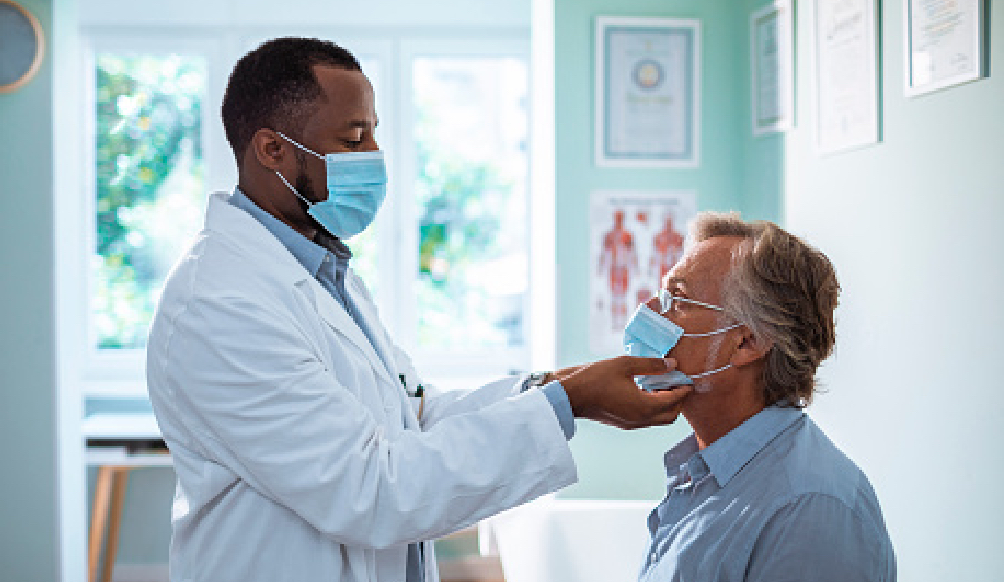Helping you deliver the highest quality care to your male patients
Many infections can affect men in very different ways than they affect women. We provide a wide range of tests that align with guidelines from leading organizations that are specific to your male patients.


The insights you need to provide the best care for your patients
Chlamydia, gonorrhea, and syphilis
According to the annual Sexually Transmitted Disease Surveillance Report, STDs increased for the fifth consecutive year—with nearly 2.5 million combined cases of chlamydia, gonorrhea, and syphilis.1
In the past few years, reported cases of chlamydia, gonorrhea, and syphilis have increased, especially among men:2
- 26.8% increase in reported cases of chlamydia2
- 62.2% increase in reported cases of gonorrhea2
- 74.2% increase in reported cases of syphilis2
Herpes
Genital herpes is common in the United States. More than 1 out of every 6 people aged 14 to 49 years have genital herpes.3
Genital herpes is caused by 2 types of viruses: herpes simplex virus type 1 (HSV-1) and herpes simplex virus type 2 (HSV-2). Oral herpes is usually caused by HSV-1 and can result in cold sores or fever blisters on or around the mouth. Oral herpes caused by HSV-1 can be spread from the mouth to the genitals through oral sex.

HIV
Human immunodeficiency virus (HIV) is the virus that causes AIDS. When a person becomes infected with HIV, the virus attacks and weakens the immune system. In the United States, people who have syphilis, gonorrhea, and herpes often also have HIV, or are more likely to get HIV in the future.4
In 2018, men accounted for 30,691 (81%) of the 37,968 new HIV diagnoses in the United States and dependent areas. Most (86%) new diagnoses among men were attributed to gay, bisexual, and other men who have sex with men.5
Today’s guidelines say that everyone between the ages of 13 and 64 should get tested for HIV6
In order to increase detection of pharyngeal or rectal infections, strategies must evolve to include more extra-genital screening for higher-risk patients, including: 7
- Men who have sex with men
- People with more than 1 sexual partner
- Transgender people who have sex with men
- People who have recently had an STI
- People who use injection drugs
- People who have sex with a partner who has HIV
HPV
Human papillomavirus (HPV) is the most common sexually transmitted infection in the United States. 79 million Americans, most in their late teens and early 20s, are infected with HPV.8
Most men who get HPV never develop symptoms and the infection usually goes away completely by itself. However, if HPV does not go away, it can cause genital warts or certain kinds of cancer. Consider testing your male patients who exhibit anything unusual such as warts, or unusual growths, lumps, or sores on the penis, scrotum, anus, mouth, or throat.

Hepatitis C
Hepatitis C virus (HCV) remains a silent epidemic in the United States, where an estimated 2.4 million people are living with chronic hepatitis C.9
According to the Centers for Disease Control and Prevention10,11:
- New hepatitis C cases are 4 times as high as they were 10 years ago
- The annual rate of reported acute hepatitis C tripled from 2009 to 2018
- Rates of acute hepatitis C among people of reproductive age are increasing
Guidelines recommend HCV screening for12,13:
- All adults aged 18 years and older
- People with recognized conditions or exposures
- People with ongoing risk factors, including persons who inject drugs (PWID) (routine periodic testing)
- Any person who requests hepatitis C testing

Mycoplasma genitalium
Mycoplasma genitalium is increasingly recognized as an important sexually transmitted infection (STI), with an estimated prevalence of 1% to 3% in the general population.14
High-risk populations may have a much higher prevalence (up to 24% among men and 16% among women), comparable to that of chlamydia.14
- Responsible for 30% of persistent or recurrent urethritis in men15
- Causes up to 20% of nonchlamydial nongonococcal infections in men16
- Infected patients are 2 times more likely to acquire HIV17
Mycoplasma genitalium infections may go unrecognized, either because infected individuals are asymptomatic or the symptoms are the same as those associated with other infections of the urogenital tract (eg, chlamydia, gonorrhea, or trichomoniasis). Accurate identification of a patient’s Mycoplasma genitalium infection status is critical for effective patient treatment for reproductive disorders.
Gram stain and culture are not clinically feasible methods of detection for Mycoplasma genitalium due to the pathogen’s lack of cell wall18 and fastidious nature.15 NAATs are preferred for detecting Mycoplasma genitalium because this pathogen cannot be visualized under a microscope and is prohibitively difficult to culture.16
A comprehensive test menu for your male patients
Laboratory Screenings
Test name
Test code
CPT Codea
LABORATORY SCREENING
Chlamydia
TEST NAME
Chlamydia trachomatis RNA, TMA, Urogenital
TEST CODE
11361
CPT Codea
87491
TEST NAME
Chlamydia trachomatis RNA, TMA, Rectal
TEST CODE
16505
CPT Codea
87491
TEST NAME
Chlamydia trachomatis RNA, TMA, Throat
TEST CODE
70048
CPT Codea
87491
LABORATORY SCREENING
Gonorrhea
TEST NAME
Neisseria gonorrhoeae RNA, TMA, Urogenital
TEST CODE
11362
CPT Codea
87591
TEST NAME
Neisseria gonorrhoeae RNA, TMA, Rectal
TEST CODE
16504
CPT Codea
87591
TEST NAME
Neisseria gonorrhoeae RNA, TMA, Throat
TEST CODE
70049
CPT Codea
87591
LABORATORY SCREENING
Chlamydia and Gonorrhea
TEST NAME
Chlamydia/Neisseria gonorrhoeae RNA, TMA, Urogenital
TEST CODE
11363
CPT Codea
87491, 87591
TEST NAME
Chlamydia/Neisseria gonorrhoeae RNA, TMA, Rectal
TEST CODE
16506
CPT Codea
87491, 87591
TEST NAME
Chlamydia/Neisseria gonorrhoeae RNA, TMA, Throat
TEST CODE
70051
CPT Codea
87491, 87591
LABORATORY SCREENING
Trichomonas vaginalis
TEST NAME
Trichomonas vaginalis RNA, Qualitative, TMA, Males
TEST CODE
90801
CPT Codea
87661
LABORATORY SCREENING
Chlamydia, Gonorrhea and Trichomonas vaginalis
TEST NAME
SureSwab®, CT/NG, T vaginalis
TEST CODE
16492
CPT Codea
87491, 87591, 87661
LABORATORY SCREENING
Mycoplasma genitalium
TEST NAME
Mycoplasma genitalium, rRNA, TMA
TEST CODE
91475
CPT Codea
87563
LABORATORY SCREENING
Herpes simplex virus 1/2 for lesions
TEST NAME
SureSwab®, Herpes Simplex Virus, Type 1 and 2 mRNA, TMA
TEST CODE
90570
CPT Codea
87529 (x2)
LABORATORY SCREENING
Herpes simplex virus 1/2 serology
TEST NAME
Herpes Simplex Virus 1 and 2 (IgG), with Reflex to HSV-2 Inhibition
TEST CODE
17169
CPT Codea
86695, 86696
LABORATORY SCREENING
Male Urethritis
TEST NAME
Sexually-Transmitted Infections (STIs) Male Urethritis Panel
TEST CODE
36964
CPT Codea
87491, 87591, 87661, 87563
LABORATORY SCREENING
Male Urethritis Expanded
TEST NAME
Sexually-Transmitted Infections (STIs) Male Urethritis Panel, Expanded
TEST CODE
38288
CPT Codea
87491, 87591, 87661, 87798 (x2), 87563
LABORATORY SCREENING
Genital Lesion
TEST NAME
Sexually-Transmitted Infections (STIs) Genital Lesion Panel
TEST CODE
38286
CPT Codea
87529 (x2), 87798
LABORATORY SCREENING
Syphilis lesion
TEST NAME
Treponema pallidum DNA, Qualitative Real-Time PCR
TEST CODE
16595
CPT Codea
87798
LABORATORY SCREENING
Syphilis serology
TEST NAME
RPR (Diagnosis) with Reflex to Titer and Confirmatory Testing
TEST CODE
36126
CPT Codea
86592
LABORATORY SCREENING
Hepatitis C
TEST NAME
Hepatitis C Antibody with Reflex to HCV, RNA, Quantitative, Real-Time PCR
TEST CODE
8472
CPT Codea
86803
LABORATORY SCREENING
HPV
TEST NAME
HPV mRNA E6/E7, Rectal
TEST CODE
91932
CPT Codea
87624
TEST NAME
HPV mRNA E6/E7, Rectal with Reflex to Genotypes, 16, 18/45
TEST CODE
92810
CPT Codea
87624
TEST NAME
HPV Genotypes 16, 18/45, Anal-Rectal
TEST CODE
92807
CPT Codea
87625
LABORATORY SCREENING
Cytology, non-gynecological
TEST NAME
Cytology, Non-Gynecological, Fluid, Washings, Brushings or FNA
TEST CODE
10676
CPT Codea
88104, 88108, 88112, 88160, 88161, 88162, 87207, 88172, 88173, 88305
Components of panels can be ordered separately.
Test codes may vary by location. Please contact your local laboratory for more information.
a The CPT® codes provided are based on American Medical Association guidelines an are for informational purposes only. CPT coding is the sole responsibility of the billing party. Please direct any questions regarding coding to the payer being billed.
References:
- CDC. 2018 STD surveillance report. Updated October 8, 2019. Accessed November 20, 2020. https://www.cdc.gov/nchhstp/newsroom/2019/2018-STD-surveillance-report.html
- CDC. Sexually transmitted disease surveillance 2016. Published September 2017. Accessed November 20, 2020. https://www.cdc.gov/std/stats16/CDC_2016_STDS_Report-for508WebSep21_2017_1644.pdf
- CDC. Genital herpes – CDC fact sheet. Updated August 28, 2017. Accessed November 20, 2020. https://www.cdc.gov/std/herpes/stdfact-herpes.htm
- CDC. STDs and HIV – CDC fact sheet. Updated March 30, 2020. Accessed November 20, 2020. https://www.cdc.gov/std/hiv/stdfact-std-hiv.htm
- CDC. HIV and men. Updated November 5, 2020. Accessed November 20, 2020. https://www.cdc.gov/hiv/group/gender/men/
- CDC. HIV testing. Updated June 9, 2020. Accessed November 20, 2020. https://www.cdc.gov/hiv/testing/index.html
- CDC. Clinical prevention guidance. Updated June 4, 2015. Accessed October 17, 2017. https://www.cdc.gov/std/tg2015/clinical.htm
- CDC. Genital HPV infection – fact sheet. Updated August 20, 2019. Accessed November 20, 2020. https://www.cdc.gov/std/hpv/stdfact-hpv.htm
- Hofmeister MG, Rosenthal EM, Barker LK, et al. Estimating prevalence of hepatitis C virus infection in the United States, 2013-2016. Hepatology. 2019;69(3):1020-1031. doi:10.1002/hep.30297
- CDC. Dramatic increases in hepatitis C. Updated April 9, 2020. Accessed May 7, 2020. https://www.cdc.gov/hepatitis/hcv/vitalsigns/index.html
- Ryerson AB, Schillie S, Barker LK, et al. Vital signs: newly reported acute and chronic hepatitis c cases—United States, 2009-2018. MMWR Morb Mortal Wkly Rep. 2020;69(14):399-404. doi:10.15585/mmwr.mm6914a2
- CDC. CDC recommendations for hepatitis C screening among adults—United States, 2020. Updated April 10, 2020. Accessed May 6, 2020. https://www.cdc.gov/mmwr/volumes/69/rr/rr6902a1.htm
- US Preventive Services Task Force, Owens DK, Davidson KW, et al. Screening for hepatitis C virus infection in adolescents and adults: US Preventive Services Task Force recommendation statement. JAMA. 2020;323(10):970-975. doi:10.1001/jama.2020.1123
- Aptima® Mycoplasma genitalium Assay [package insert]. Hologic Inc.; 2019.
- CDC. Emerging issues. Updated June 4, 2015. Accessed November 20, 2019. https://www.cdc.gov/std/tg2015/emerging.htm
- Workowski KA, Bolan GA, Centers for Disease Control and Prevention. Sexually transmitted diseases treatment guidelines, 2015. MMWR Recomm Rep. 2015;64(RR-03):1-137.
- Napierala Mavedzenge S, Weiss HA. Association of Mycoplasma genitalium and HIV infection: a systematic review and meta-analysis. AIDS. 2009;23(5):611-620. doi:10.1097/QAD.0b013e328323da3e
- Manhart LE, Broad JM, Golden MR. Mycoplasma genitalium: should we treat and how? Clin Infect Dis. 2011;53(S3):S129-S142. doi:10.1093/cid/cir702



